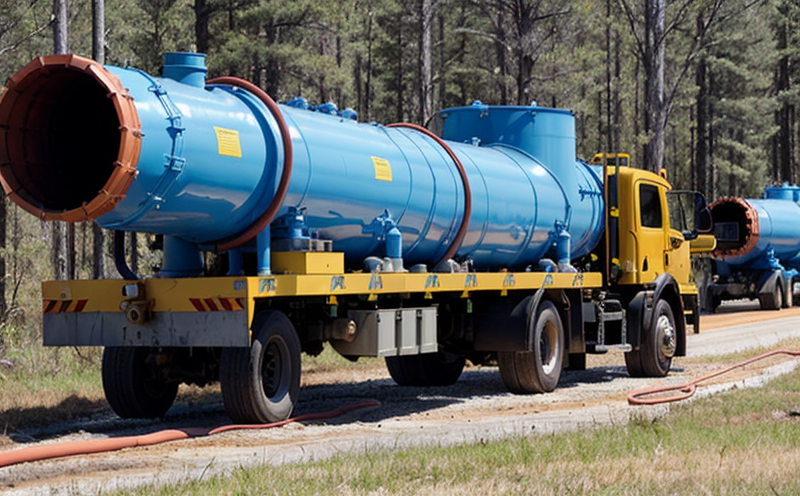ISO 6326 Trace Constituents Testing in Natural Gas
The ISO 6326 standard is a cornerstone in the analysis of trace constituents within natural gas, ensuring safe and reliable distribution. This service plays an essential role for quality managers, compliance officers, R&D engineers, and procurement teams by providing robust testing that ensures the integrity of natural gas pipelines.
Trace constituents can significantly impact the performance, safety, and economic efficiency of a pipeline system. These trace elements include hydrogen sulfide (H₂S), mercaptans, and other volatile organic compounds (VOCs). Accurate measurement is critical to prevent corrosion, protect equipment, and ensure safe distribution.
The testing process involves several stages: sampling, preparation, analysis, and reporting. Samples are taken from the natural gas stream at various points along the pipeline network. These samples are then prepared for analysis by removing any non-condensable gases and water, ensuring that only trace constituents remain for measurement.
Our state-of-the-art laboratory uses advanced instrumentation to perform these analyses. The key instruments include gas chromatographs (GC), mass spectrometers (MS), and infrared spectroscopy systems (IR). These tools provide precise quantification of the trace elements present in the sample, adhering strictly to ISO 6326 guidelines.
After analysis, detailed reports are generated that outline the concentration levels of each identified trace constituent. These reports serve multiple purposes: they inform quality control protocols, guide maintenance schedules, and provide data for long-term trend analysis. This information is crucial for identifying potential issues early on, thereby reducing the risk of costly disruptions.
The ISO 6326 standard specifies acceptance criteria based on permissible limits set by regulatory bodies such as the American Public Gas Association (APGA) and the International Organization for Standardization (ISO). Compliance with these standards ensures that natural gas meets both domestic and international safety, quality, and performance expectations. By adhering to this process, we ensure that our clients receive accurate, reliable data which can be used to make informed decisions about their pipeline systems.
Our service is not just a technical exercise; it's part of a broader strategy aimed at optimizing operational efficiency while maintaining the highest standards of safety and environmental responsibility. This approach supports the sustainable operation of natural gas distribution networks, contributing positively to both economic growth and public welfare.
| Trace Constituent | Units | Acceptance Criteria (ISO 6326) |
|---|---|---|
| Mercaptans | μg/m³ | ≤10 μg/m³ |
| H₂S | ppm | 0.5 ppm max. |
| VOCs (Total) | mg/m³ | ≤1 mg/m³ |
The acceptance criteria outlined in the ISO 6326 standard are conservative, aiming to minimize risks associated with trace constituents. By adhering strictly to these standards and employing cutting-edge technology, we ensure that our clients receive results that align perfectly with industry best practices.
- Sampling: Careful selection of sample points ensures representative data.
- Preparation: Rigorous preparation procedures eliminate interferences from non-condensable gases and water.
- Analysis: Advanced instrumentation provides precise measurements, leading to accurate reports.
In conclusion, ISO 6326 trace constituents testing is more than just a compliance exercise; it's a strategic investment in the longevity and safety of natural gas distribution systems. Our service offers unparalleled accuracy and reliability, backed by decades of experience and cutting-edge technology.
Industry Applications
The application of ISO 6326 trace constituents testing spans various sectors within the power & utilities industry, including natural gas distribution companies, pipeline operators, and energy providers. This service is crucial for ensuring that natural gas meets stringent quality standards before it reaches consumers.
- Quality Control: Regular sampling and analysis ensure consistent product quality.
- Risk Management: Early detection of trace contaminants helps prevent pipeline corrosion and equipment failures.
The following table highlights the specific applications within different segments of the industry:
| Sector | Application |
|---|---|
| Natural Gas Distribution Companies | Ensure safe and reliable distribution. |
| Pipeline Operators | Prevent corrosion, protect equipment. |
| Energy Providers | Maintain compliance with international standards. |
The importance of ISO 6326 trace constituents testing cannot be overstated. It contributes to the overall safety and efficiency of natural gas distribution networks, making it an indispensable tool for industry professionals.
Customer Impact and Satisfaction
The implementation of ISO 6326 trace constituents testing has numerous positive impacts on customers in the power & utilities sector. Compliance with these standards ensures that natural gas products meet international quality benchmarks, enhancing customer satisfaction through consistent performance.
- Enhanced Safety: By detecting and managing trace contaminants, we help prevent pipeline failures and potential hazards.
- Improved Efficiency: Accurate testing leads to optimized maintenance schedules and reduced downtime.
The following list outlines some of the key benefits that customers experience as a result of our service:
- Compliance with international safety standards.
- Precise measurement of trace constituents for better decision-making.
- Support for sustainable operations and environmental responsibility.
We pride ourselves on delivering high-quality, reliable testing services that exceed customer expectations. Our commitment to excellence ensures that our clients can trust us with their most critical projects.
International Acceptance and Recognition
The ISO 6326 standard for trace constituents in natural gas is internationally recognized and widely accepted across the power & utilities sector. This global recognition underscores its importance as a benchmark for quality assurance and safety.
Countries around the world, including those that are members of organizations like the International Organization for Standardization (ISO) and the American Petroleum Institute (API), have adopted this standard to ensure consistent testing practices. By adhering to ISO 6326 guidelines, laboratories can provide results that are comparable across borders.
The acceptance of this standard is further bolstered by its alignment with other relevant international standards such as ASTM D1945 and EN 1801. These additional standards offer complementary guidance on the analysis of trace constituents in natural gas, reinforcing the reliability and accuracy of our testing services.
Our laboratory's commitment to adhering strictly to ISO 6326 ensures that we provide results that are not only accurate but also internationally recognized and respected. This level of consistency is crucial for companies operating across multiple jurisdictions or working with international partners.





